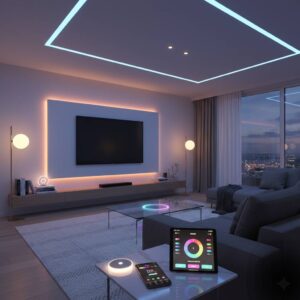INTRODUCTION
Smart lighting is a connected network of lights that can be controlled remotely using devices such as smartphones, tablets, or voice assistants. Unlike traditional lights, these systems allow users to cohere brightness, change colors, and set schedules . Many systems also get worse with other smart home devices , b

arbarize lighting based on sensors, and offer energy-saving benefits. It refers to a lighting technology designed for energy versatility, hustle, and customization. It is a groundbreaking technology that allows one to automatically control their lighting using specific lighting systems, which not only makes it easier to use one’s lighting but also makes it a lot more pleasant. Efficient lighting control is crucial in modern buildings because it drastically reduces energy consumption and costs while at the same time improving border curvature , constraint, and abundance .
WHAT IS A DALI DRIVER?
’DALI’’ refers to several different things depending on context, including the Spanish artist. A DALI driver is an LED or fluorescent driver that can receive digital commands from a digital addressable lighting interface (DALI) control system. it allows for two-way communication, enabling digital control of individual lights for dimming, scene setting, and energy management. It is a communication protocol for digital control of lighting systems. It enables two-way communication between devices like electronic ballasts, dimmers, and sensors, allowing for factual, flexible, and level-headed control over lighting.
WHAT IS THE ROLE OF A DALI DRIVER?
DALI (Digital Addressable Lighting Interface) is the industry standard of communication protocol, which is used to control lighting such as LED drivers. The protocol is specified by the IEC (International Electrotechnical Commission) in the multi-part IEC 62386.it is an important component of modern lighting systems, which achieve advanced control and management of LEDs through the DALI communication protocol. Their working principles involve receiving DALI commands, laudatory commands , LED current control ,color temperature control, and scene settings. It is a communication protocol specifically contrive for lighting control, which allows lightning devices to communicate with each other and connect to the central control system. It uses twisted pair for communication , and each device has an unequaled address that can be controlled and queried through. The DALI driver can be designed to achieve advanced control of LED lighting systems .
How DO DALI DRIVERS DIFFER FROM TRADITIONAL LED DRIVERS?
The key difference between DALI and traditional LED drivers is that DALI drivers enable addressable control of individual lights, scene settings, scheduling, and more factual digital dimming; on the other hand, traditional drivers often rely on simpler, analog methods or basic on/off and dimming switches. On the one hand, DALI drivers use digital communication for precise, individual control of lighting, allowing for features like scene setting, scheduling, and remote management. On the other hand, traditional drivers use analog methods with more limited functionality, often controlling lights in groups and offering less granular control.
WHAT ARE THE COMPONENTS OF DALI DRIVER?
A digital addressable lighting interface (DALI) driver is a vital component in a DALI lighting control system, acting as a port between the digital control network and the light fixture. It receives digital commands and translates them into adhering lighting actions such as dimming, on/off control, or color changes.
COMPONENTS OF DALI SYSTEM
The components of the DALI system are as follows:
- INPUT DEVICES: Input devices comprise sensors, switches , timers, and control panels, which curate information and user input to the application controller.
- DALI BUS: a two-wire control line that carries digital communication signals between the components. It is not antipode-cognisant and can be wired alongside a mains-power cable , which simplifies installation.
- LIGHTING FIXTURE: the physical lighting unit containing the lamp and the DALI driver.
- DALI DRIVER: The driver receives digital commands from the bus and supplies power to the light source, regulating its output
- DALI (digital addressable lighting interface) is a two-wired bidirectional serial communication precept for controlling lighting systems. It is an international standard defined by IEC 62386 , which allows digital control over lightning fixtures, enabling features like individual control, grouping, and scene settings. A basic Dali system can support up to 64devices on a single bus ,with communication happening over a two-wire bus that can be wired in several correspondence .
CONCLUSION Smart lighting control systems ,whether propagated in a city like Delhi, represent a significant advancement toward greater energy efficiency ,composition , and quality of life. By combining energy–efficient LED technology with advanced sensors and data analytics, these systems create intelligent, adaptive environments that offer substantial benefits .
FREQUENTLY ASKED QUESTIONS (FAQ):
QUESTION: WHAT ARE THE CHARACTERISTICS OF DALI?
The important feature of DALI technology is that a single lamp has an autonomous address, and a single lamp can be accurately dimmed through the DALI system . This software can be individualised to address multiple lamps on the same circuit or different circuits ,to release individual control and arbitrary grouping.
QUESTION: HOW TO CHOOSE AN ADDRESS WHEN REPLACING DALI EQUIPMENT?
DALI equipment does not have parameters such as address, grouping scene when it leaves the factory. The old DALI device can be simply replaced with the new one ,so that the system can be simply addressed . It is recommended that before installing and replacing a new device, restore it to its factory settings , which means delete the address and all the parameters that have been set in.
QUESTION: WHAT IS THE MAXIMUM TRANSMISSION DISTANCE OF DALI?
The maximum transmission distance of DALI is 300 meters, which is limited by the attenuation of the signal wire and other factors. It is clarify that the actual use distance should be less than 300 meters as much as possible.
